A uniform chain of mass m and length l hangs on a thread and touches the surface of a table by its lower end. Thread breaks suddenly. Find the force exerted by the table on the chain when half of its length has fallen on the table. The fallen part does not form heap
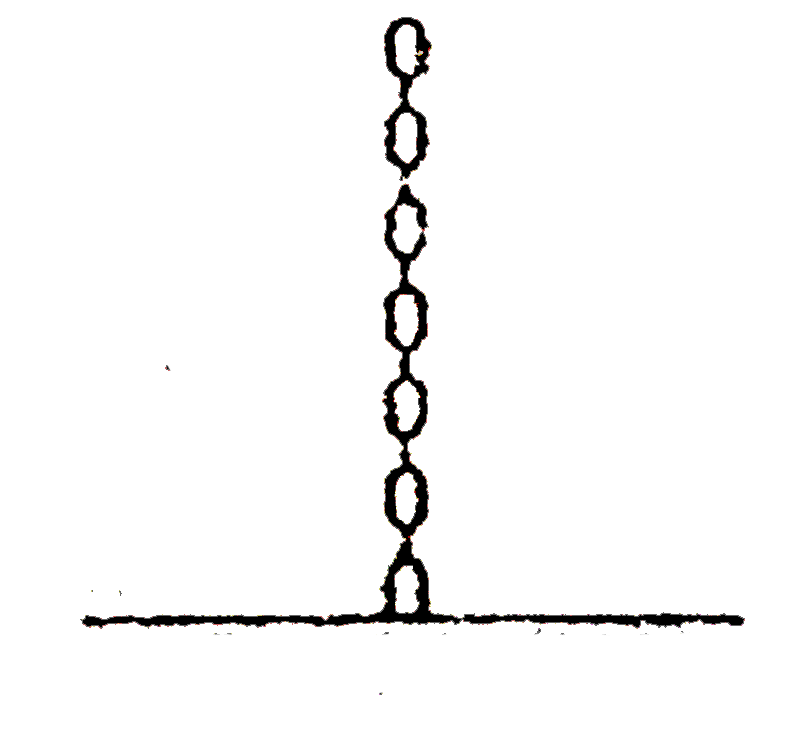
The correct Answer is:A
Force exerted by the chain on the table consists of two parts:
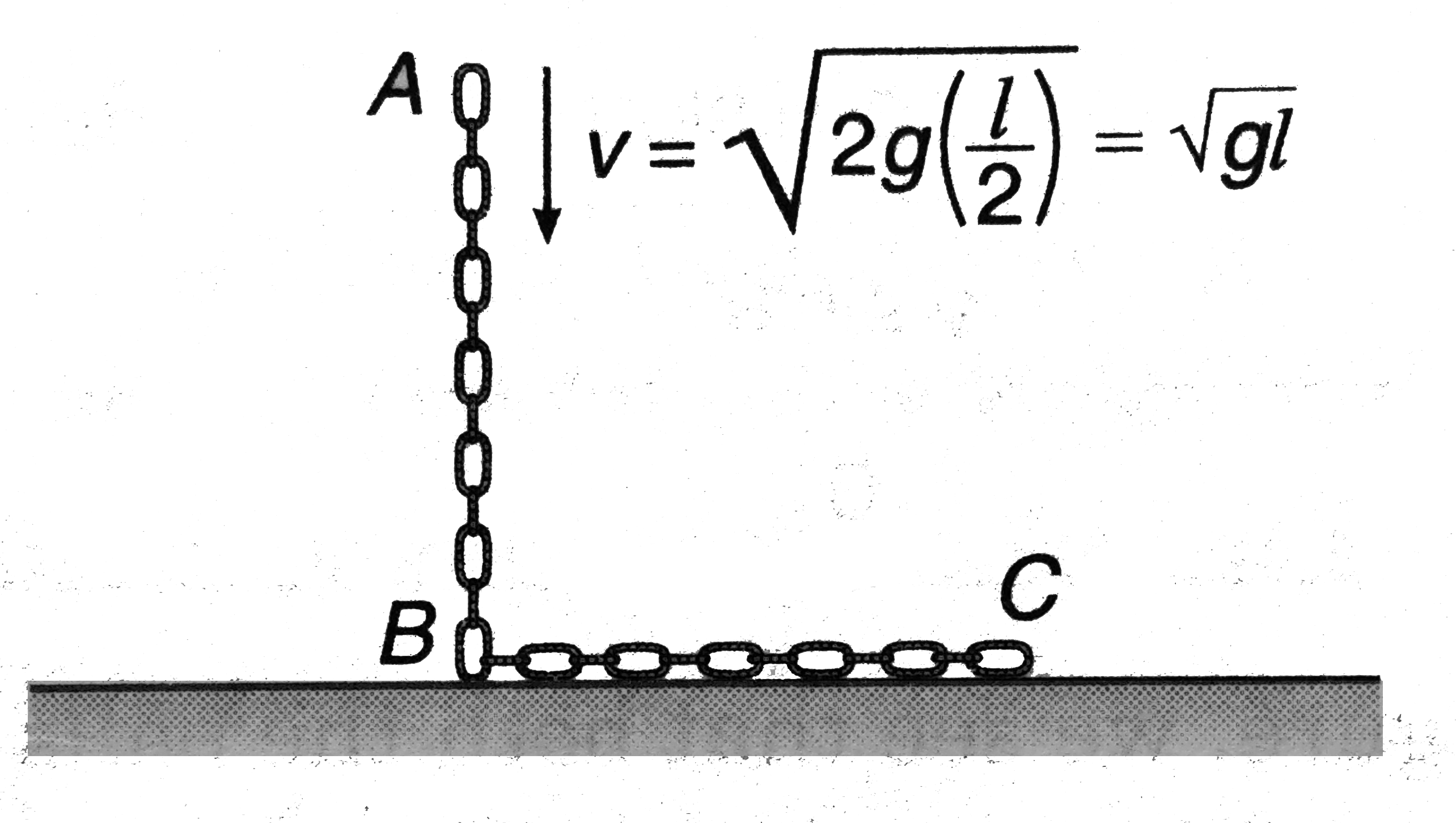
1. Weight of the portion BC of the chain lying on the table,
W=mg2 (downwards)
2. Thrust force Ft=λv2
Here, λ=mass per unit length of chain=ml
v2=(√gl)2=gl
∴Ft=(ml)(gl)=mg (downwards)
∴ Net force exerted by the chain on the table is
F=W+Ft=mg2+mg=32mg (downwards)
So, from Newton's third law the force exerted by the table on the chain will be 32mg(vertically upwards).
Topper's Solved these Questions
- CENTRE OF MASS, LINEAR MOMENTUM AND COLLISIONBOOK - DC PANDEY ENGLISHCHAPTER - CENTRE OF MASS, LINEAR MOMENTUM AND COLLISIONEXERCISE - Exercise 11.1
13 Videos
- CENTRE OF MASS, LINEAR MOMENTUM AND COLLISIONBOOK - DC PANDEY ENGLISHCHAPTER - CENTRE OF MASS, LINEAR MOMENTUM AND COLLISIONEXERCISE - Exercise 11.2
6 Videos
- CENTRE OF MASS, LINEAR MOMENTUM AND COLLISIONBOOK - DC PANDEY ENGLISHCHAPTER - CENTRE OF MASS, LINEAR MOMENTUM AND COLLISIONEXERCISE - Type 1
1 Video
- CENTRE OF MASS, IMPULSE AND MOMENTUMBOOK - DC PANDEY ENGLISHCHAPTER - CENTRE OF MASS, IMPULSE AND MOMENTUMEXERCISE - Comprehension type questions
15 Videos
- CIRCULAR MOTIONBOOK - DC PANDEY ENGLISHCHAPTER - CIRCULAR MOTIONEXERCISE - Medical entrances s gallery
19 Videos
Similar Questions
What is the difference between centre of mass and centre of gravity?
View SolutionA block of mass 1kg is at x=10m and moving towards negative x−aξs with velocity 6m/s. Another block of mass 2kg is at x=12m and moving towards positive x−axis with velocity 4m/s at the same instant. Find position of their centre of mass after 2s.
View SolutionTwo toy trains each of mass 'M' are moving in opposite directions with velocities v1 and v2 over two smooth rails. Two stuntmen of mass 'm' each are also moving with the trains (at rest w.r.t. trains). When trains are opposite to each other the stuntmen interchange their positions, then find the final velocities of the trains.
View SolutionComprehension # 1
If net force on a system in a particular direction is zero (say in horizontal direction), we can apply: ΣmRxR=ΣmLxL,ΣmRvR=ΣmLvL and ΣmRaR=ΣmLaL
Here R stands for the masses which are moving towards right and L for the masses towards left, x is displacement, v is velocity and a the acceleration (all with respect to ground).
A small block of mass m=1kg is placed over a wedge of mass M=4kg as shown in figure. Mass m is released from rest. All surface are smooth. Origin O is as shown.
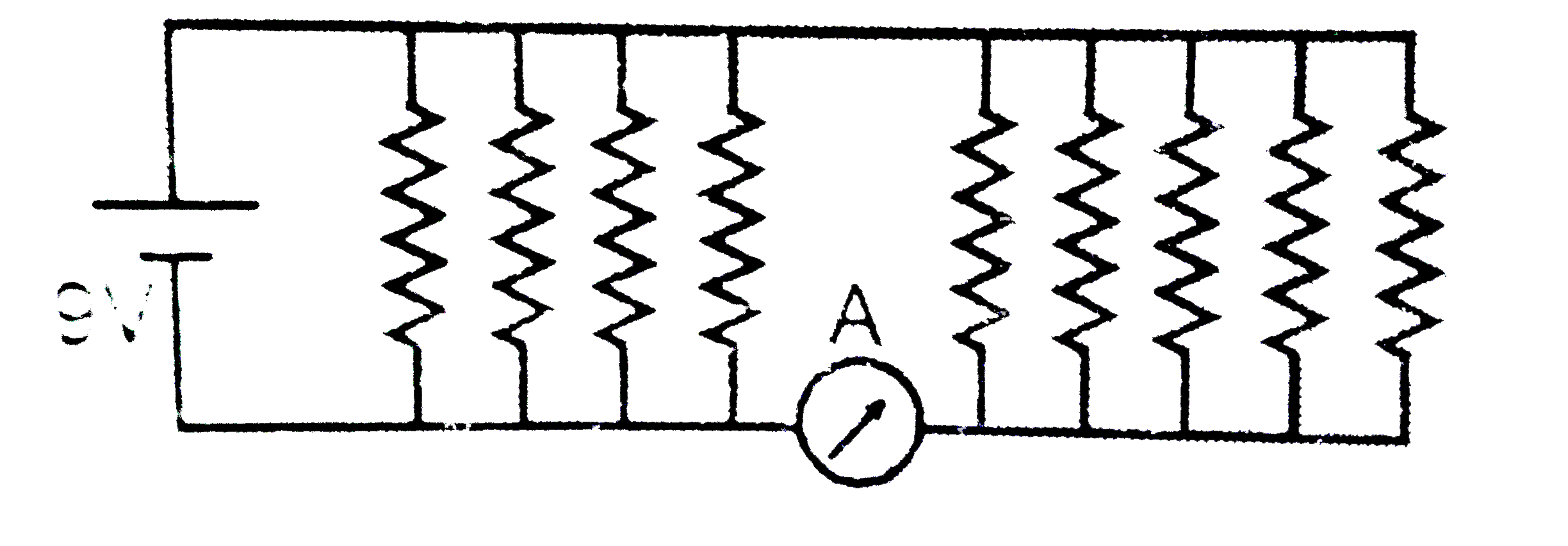
Final velocity of the wedge is ..........m/s :-
View Solutionin the given figure, α=15m/s2 represents the total accleration of a particle moving in the clockwise direction on a circle radius R = 2.5m aat a given of time The speed of the particle is
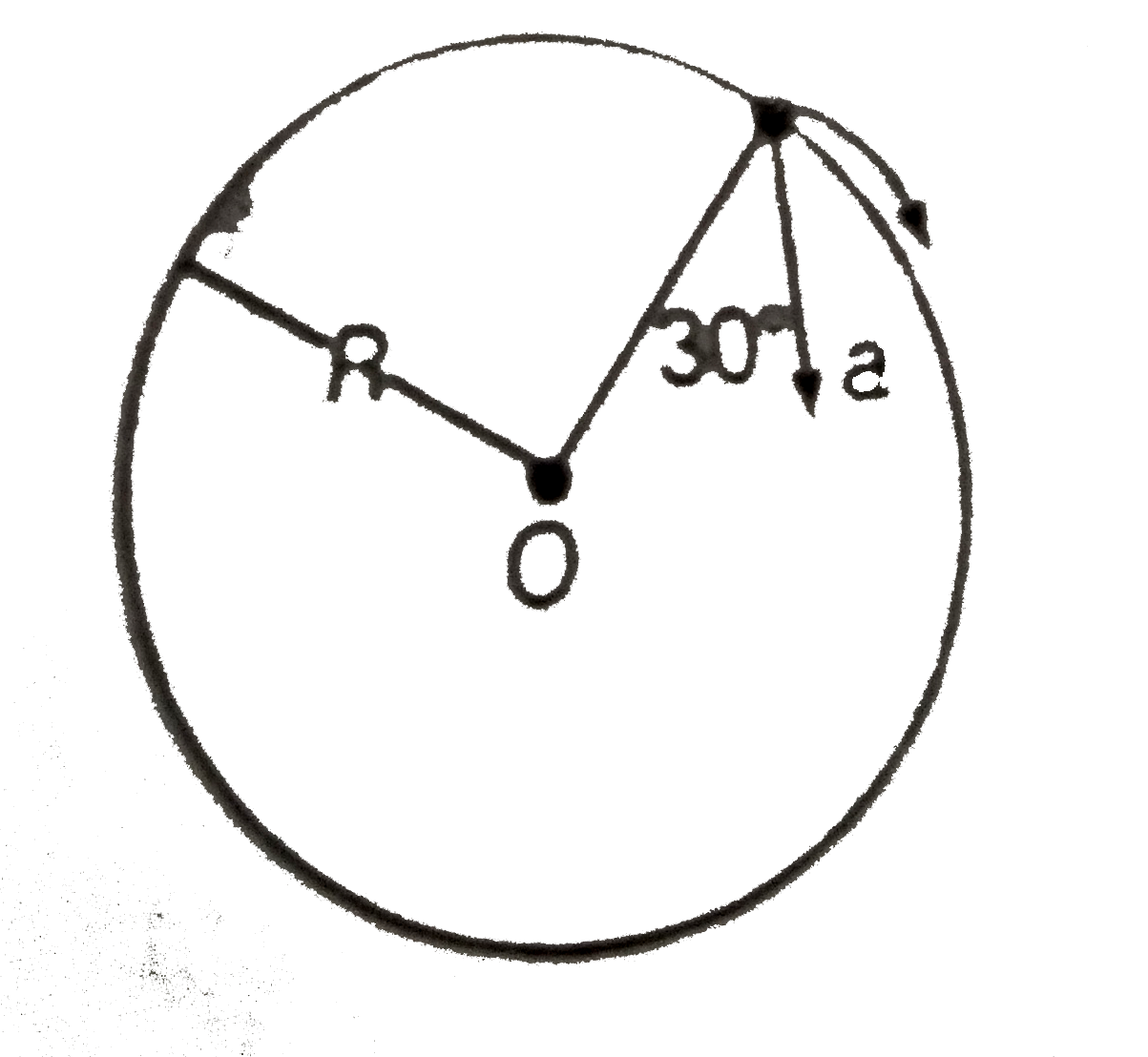
View SolutionA chain hangs on a thread and touches the surface of a table by its lower end. Show that after the thread has been burned through, the force exerted on the table by the falling part of the chain at any moment is twice as great as the force of pressure exerted by the part already resting on the table.
View SolutionA uniform chain of mass m and length l hangs on a thread and touches the surface of a table by its lower end. Thread breaks suddenly. Find the force exerted by the table on the chain when half of its length has fallen on the table. The fallen part does not form heap

View SolutionA thin, uniform chain is hanging vertically and its bottom end is touching a table . The mass of the chain is m and its length is l . At the moment t=0, the chain is released. Calculate the force that the chain exerts on the table after t seconds.
View SolutionA uniform chain is held on a frictionless table with one third of its length hanging over the edge. IF the chain has a length l and a mass m, how much work is required to pull the hanging part back on the table ?
View SolutionA uniform chain of mass m and length l is lying on a horizontal table with one-third of its length hanging over the edge of the table.
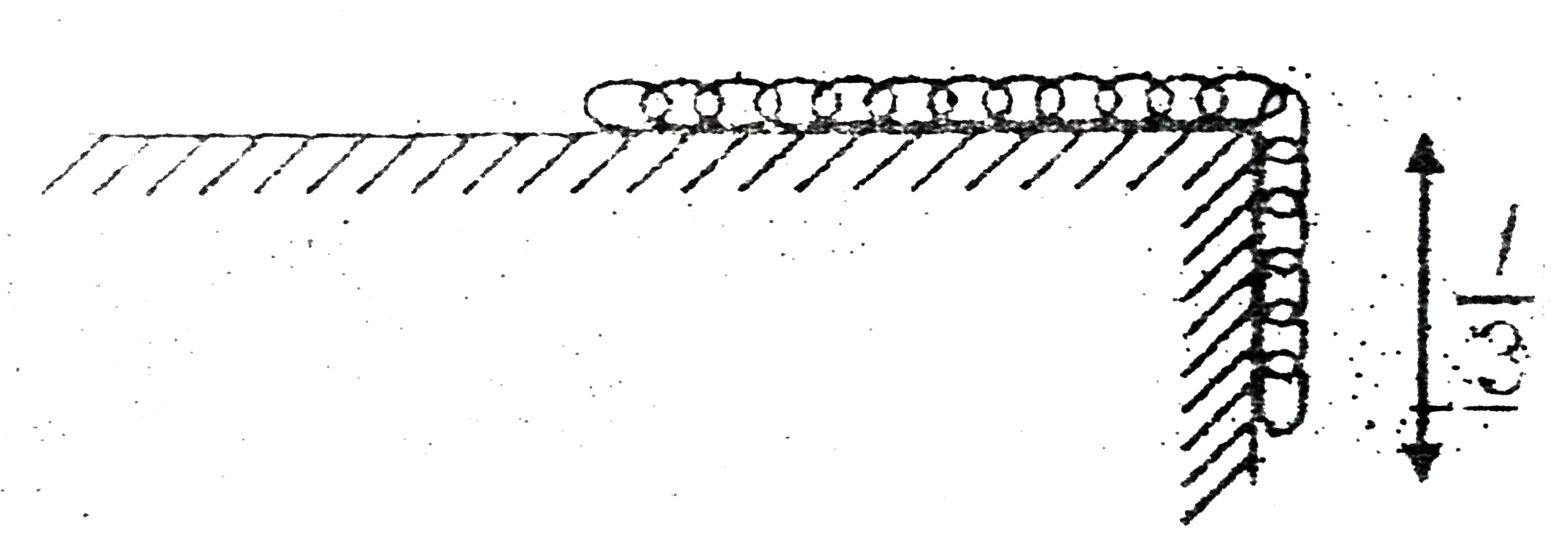
If the chain is limiting equlibrium, what is the coefficient of friction for the contact between table and chain?
View SolutionA uniform chain of length l begins to fall with a velocity v on the table. Find the thrust force exerted by the chain on the table.
View SolutionA chain of mass M and length l is held vertically such that its bottom end just touches the surface of a horizontal table. The chain is released from rest. Assume that the portion of chain on the table does not form a heap. The momentum of the portion of the chain above the table after the top end of the chain falls down by a distance l/8 .
View SolutionA uniform chain of mass m and length l is on a smooth horizontal table with (1/n)^th part of its leght is hanging from one end of the table. The velocity of the chain, when it completely slips off the table is
View SolutionA uniform chain in held on a frictionless table with one-third of its length hanging over the edge. If the chain has a length l and mass m , how much work is required to pull the hanging part back on the table ?
View SolutionA very flexible chain of length L and mass M is vertically suspended with its lower end just touching the table. If it is released so that each link strikes the table and comes to rest, what force the chain will exert on table at the moment 'y 'part of length falls on table ?
View SolutionA very ftexible chain of length L and mass M is vertically suspended with its lower end just touching the table. If it is is released so that each link strikes the table and comes to rest, what force the chain will exert on table at the moment 'y' part of length falls on table ?
View Solution

